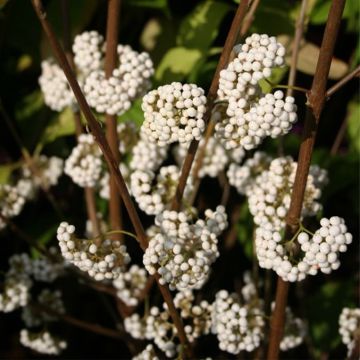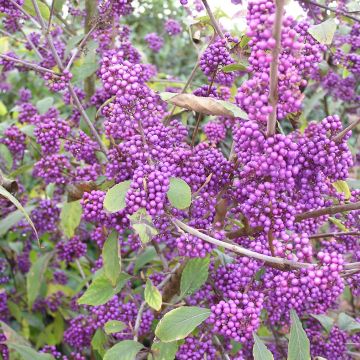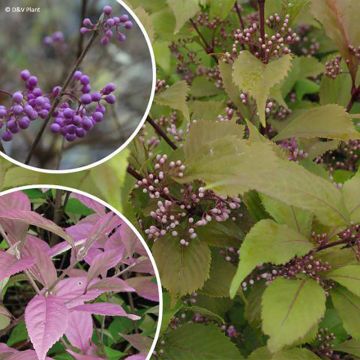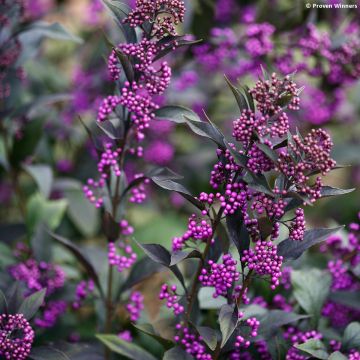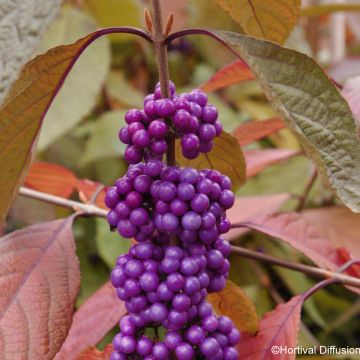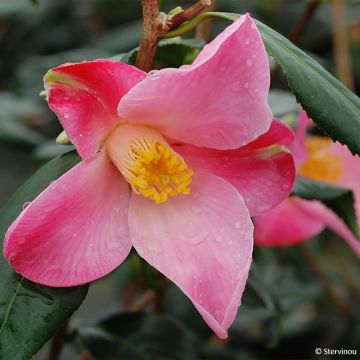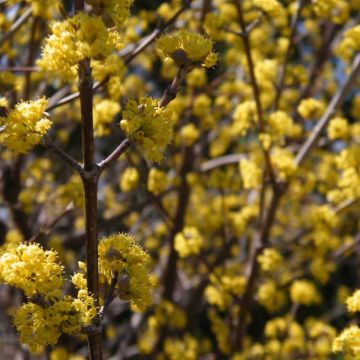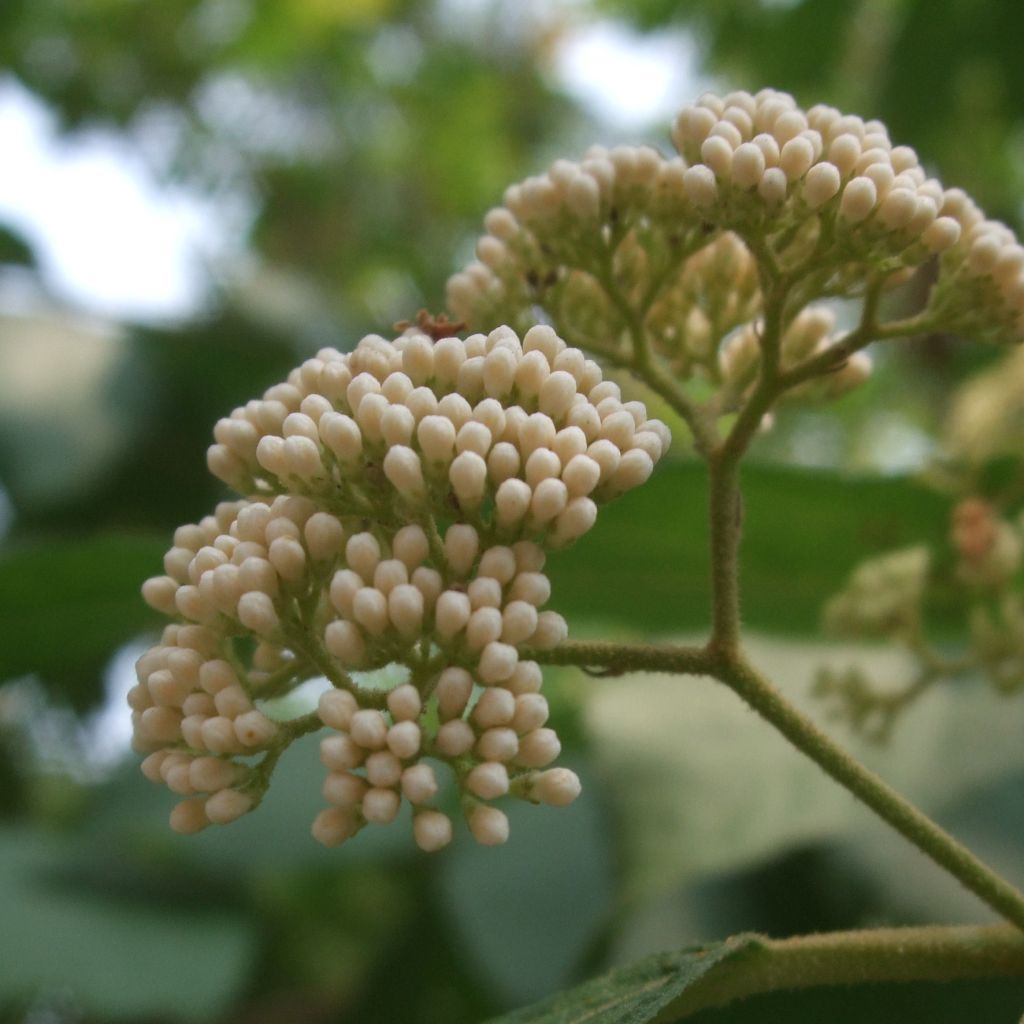

Callicarpa japonica Leucocarpa
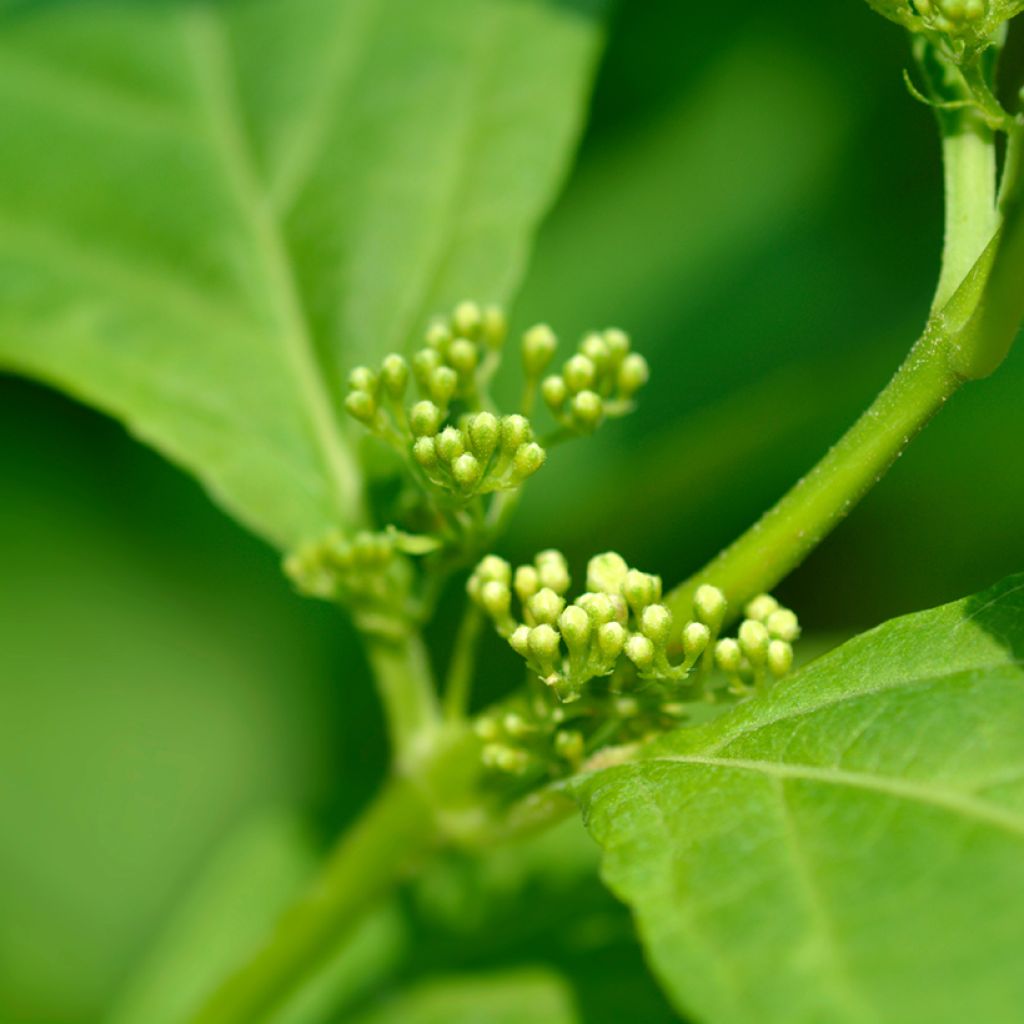

Callicarpa japonica Leucocarpa


Callicarpa japonica Leucocarpa
Callicarpa japonica Leucocarpa
Callicarpa japonica Leucocarpa
Japanese beautyberry
This item cannot be shipped to the selected country
Delivery charge from €5.90
Delivery to Corse prohibited
More information
Schedule delivery date,
and select date in basket
This plant carries a 24 months recovery warranty
More information
We guarantee the quality of our plants for a full growing cycle, and will replace at our expense any plant that fails to recover under normal climatic and planting conditions.
From €5.90 for pickup delivery and €6.90 for home delivery
Express home delivery from €8.90.
Delivery to Corse prohibited: UE law prohibits the import of this plant from mainland France to Corse as part of the fight against Xylella fastidiosa. Please accept our sincere apologies.
More information
Does this plant fit my garden?
Set up your Plantfit profile →
Description
Callicarpa japonica 'Leucocarpa' is an original and unusual bush, very decorative, of medium size, forming a pretty dense and compact bush. Of great refinement, graceful and naturally elegant, it displays in autumn, not only splendid foliage colours, but also and above all, a profusion of clusters of ivory white berries, like pearls, persisting all winter on the bare branches. Too little known, it is to be adopted without delay in the garden for its attractive and bright fruiting!
Belonging to the Lamiaceae family, this white Japanese Callicarpa, also called Candy Tree, is a beautiful ornamental bush, with moderate growth, with long elegantly arched and slightly drooping branches, measuring 1.50in all directions. This Asian bush is native to China, Korea, and Japan. Its deciduous foliage is composed of thin leaves 8 to 12cm (4.7in) long, oval to lanceolate, pale green, taking superb gradients of gold, purple, and bronze in autumn. From August to September, tiny pale pinkish-white flowers appear in axillary clusters measuring 3cm (1.2in) in diameter. They are followed in autumn by clusters of spherical waxy ivory white berries, resembling small beads or pearls. These remain very decorative for a long time, as they persist all winter, even after the leaves have fallen. The berries are not edible, as they have very astringent properties. To obtain abundant flowering and fruiting, it is advisable to plant several subjects close to each other, in order to ensure better pollination.
This Japanese Callicarpa, very easy to grow, requires little maintenance. Very accommodating, it is content with ordinary to fertile, well-drained soil, and appreciates a sunny or semi-shaded exposure. It can be planted in isolation where its fruiting and magnificent autumn foliage will be highlighted. However, it is rather advisable to plant it in groups as the proximity of several subjects ensures better pollination and therefore more abundant fruiting. It will ideally be placed in a country hedge, or within a shrub bed, in the company of shrubs with autumn or winter flowering; or even associated with perennials with late summer or winter flowering. It will harmonize perfectly with other attractive fruit-bearing shrubs, such as other species of Callicarpa, Euonymus, Symphoricarpos... Its branches with very decorative berries will make superb bouquets of autumn foliage and branches, and will also wonderfully garnish flower bouquets in the house.
The Callicarpa genus was first described in 1753 by the Swedish naturalist Carl von Linnaeus (1707-1778). The specific epithet 'Leucocarpa' means in Greek, white fruit, alluding to the white fruiting of this Candy Tree.
Report an error about the product description
Callicarpa japonica Leucocarpa in pictures




Plant habit
Flowering
Foliage
Botanical data
Callicarpa
japonica
Leucocarpa
Lamiaceae
Japanese beautyberry
East Asia
Other Callicarpa
Planting and care
Callicarpa japonica 'Leucocarpa', very easy to grow and highly resistant to diseases, enjoys a sunny or even semi-shady exposure. Very accommodating, it will thrive in ordinary soil, as well as in good garden soil or in a richer and more fertile soil, but always well drained and without too much limestone. It is hardy up to -15°C, but it is preferable to protect it from cold winds and heavy frosts. An installation against a south-facing wall would be ideal. Mulch the base of the young plants for three consecutive winters in cold regions, as they are more sensitive to spring frosts than adult subjects. It should be noted that even if it has suffered from frosts, simply pruning it heavily will make it regrow from the base. Furthermore, it will be even more resistant to severe cold if it has benefited from a long, hot, and dry summer. Planting can be done in autumn or spring. Propagation is done by cuttings in June-July, by taking lateral ends of 8 to 10cm. Root them in turf and sand, then once well rooted, plant them in pots filled with compost.
Planting period
Intended location
Care
-
, onOrder confirmed
Reply from on Promesse de fleurs
Hedge shrubs
Haven't found what you were looking for?
Hardiness is the lowest winter temperature a plant can endure without suffering serious damage or even dying. However, hardiness is affected by location (a sheltered area, such as a patio), protection (winter cover) and soil type (hardiness is improved by well-drained soil).

Photo Sharing Terms & Conditions
In order to encourage gardeners to interact and share their experiences, Promesse de fleurs offers various media enabling content to be uploaded onto its Site - in particular via the ‘Photo sharing’ module.
The User agrees to refrain from:
- Posting any content that is illegal, prejudicial, insulting, racist, inciteful to hatred, revisionist, contrary to public decency, that infringes on privacy or on the privacy rights of third parties, in particular the publicity rights of persons and goods, intellectual property rights, or the right to privacy.
- Submitting content on behalf of a third party;
- Impersonate the identity of a third party and/or publish any personal information about a third party;
In general, the User undertakes to refrain from any unethical behaviour.
All Content (in particular text, comments, files, images, photos, videos, creative works, etc.), which may be subject to property or intellectual property rights, image or other private rights, shall remain the property of the User, subject to the limited rights granted by the terms of the licence granted by Promesse de fleurs as stated below. Users are at liberty to publish or not to publish such Content on the Site, notably via the ‘Photo Sharing’ facility, and accept that this Content shall be made public and freely accessible, notably on the Internet.
Users further acknowledge, undertake to have ,and guarantee that they hold all necessary rights and permissions to publish such material on the Site, in particular with regard to the legislation in force pertaining to any privacy, property, intellectual property, image, or contractual rights, or rights of any other nature. By publishing such Content on the Site, Users acknowledge accepting full liability as publishers of the Content within the meaning of the law, and grant Promesse de fleurs, free of charge, an inclusive, worldwide licence for the said Content for the entire duration of its publication, including all reproduction, representation, up/downloading, displaying, performing, transmission, and storage rights.
Users also grant permission for their name to be linked to the Content and accept that this link may not always be made available.
By engaging in posting material, Users consent to their Content becoming automatically accessible on the Internet, in particular on other sites and/or blogs and/or web pages of the Promesse de fleurs site, including in particular social pages and the Promesse de fleurs catalogue.
Users may secure the removal of entrusted content free of charge by issuing a simple request via our contact form.
The flowering period indicated on our website applies to countries and regions located in USDA zone 8 (France, the United Kingdom, Ireland, the Netherlands, etc.)
It will vary according to where you live:
- In zones 9 to 10 (Italy, Spain, Greece, etc.), flowering will occur about 2 to 4 weeks earlier.
- In zones 6 to 7 (Germany, Poland, Slovenia, and lower mountainous regions), flowering will be delayed by 2 to 3 weeks.
- In zone 5 (Central Europe, Scandinavia), blooming will be delayed by 3 to 5 weeks.
In temperate climates, pruning of spring-flowering shrubs (forsythia, spireas, etc.) should be done just after flowering.
Pruning of summer-flowering shrubs (Indian Lilac, Perovskia, etc.) can be done in winter or spring.
In cold regions as well as with frost-sensitive plants, avoid pruning too early when severe frosts may still occur.
The planting period indicated on our website applies to countries and regions located in USDA zone 8 (France, United Kingdom, Ireland, Netherlands).
It will vary according to where you live:
- In Mediterranean zones (Marseille, Madrid, Milan, etc.), autumn and winter are the best planting periods.
- In continental zones (Strasbourg, Munich, Vienna, etc.), delay planting by 2 to 3 weeks in spring and bring it forward by 2 to 4 weeks in autumn.
- In mountainous regions (the Alps, Pyrenees, Carpathians, etc.), it is best to plant in late spring (May-June) or late summer (August-September).
The harvesting period indicated on our website applies to countries and regions in USDA zone 8 (France, England, Ireland, the Netherlands).
In colder areas (Scandinavia, Poland, Austria...) fruit and vegetable harvests are likely to be delayed by 3-4 weeks.
In warmer areas (Italy, Spain, Greece, etc.), harvesting will probably take place earlier, depending on weather conditions.
The sowing periods indicated on our website apply to countries and regions within USDA Zone 8 (France, UK, Ireland, Netherlands).
In colder areas (Scandinavia, Poland, Austria...), delay any outdoor sowing by 3-4 weeks, or sow under glass.
In warmer climes (Italy, Spain, Greece, etc.), bring outdoor sowing forward by a few weeks.

































